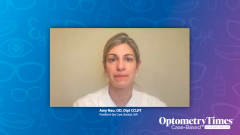
Demodex Patient Case #2
Dr Amy Nau shares a patient case involving a female with Demodex infestation, ultimately treated with lotilaner.
Episodes in this series
This is a video synopsis of a discussion involving Dr. Amy Nau, OD, Dipl CCLRT, focusing on two cases – Blake and Hope – addressing ocular conditions, including Demodex blepharitis.
Case 2: Hope (55-year-old white female)
Hope, an established patient not seen since 2019, sought emergency examination due to severe eye itching. Her history included keratoconus, meibomian gland dysfunction, and corneal gas permeable lenses alternated with glasses. Notably, she had inflammatory bowel disease in remission and active leukemia. Examination revealed margin telangiectasis, obstructive meibomian gland disease, stable keratoconus, and mild Demodex infestation. Despite improvements in meibomian gland issues and tear film chemistry, Demodex persisted.
Dr. Nau's initial treatment involved warm compresses with an iLux, 2% tea tree oil, and mineral oil at night. Due to abnormal MMP9 (matrix metalloproteinase 9) and osmolarity, Hope underwent an I.C. vis taper over two weeks with two-tier cares. Despite difficulties in expressing the waxy Demodex, four IPL sessions with expression were performed, along with Regener-Eyes. Additionally, Xiidra twice a day, and XDEMVY due to non-eradication of Demodex were prescribed. At the six-month follow-up, despite improvement, mild itching persisted.
Dr. Nau discussed the challenges of managing patients with keratoconus, emphasizing the need to optimize the ocular surface for those dependent on contact lenses. The use of periorbital neurotoxin influenced management, requiring protective measures for lid seal at night. Each aspect of Hope's complex condition required separate consideration and intervention.
In conclusion, Dr. Amy Nau showcased a nuanced approach to treating ocular conditions, addressing the multifaceted nature of patients' concerns and tailoring interventions for optimal outcomes.
Video synopsis is AI-generated and reviewed by Optometry Times® editorial staff.
Newsletter
Want more insights like this? Subscribe to Optometry Times and get clinical pearls and practice tips delivered straight to your inbox.

















































.png)


